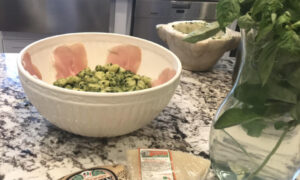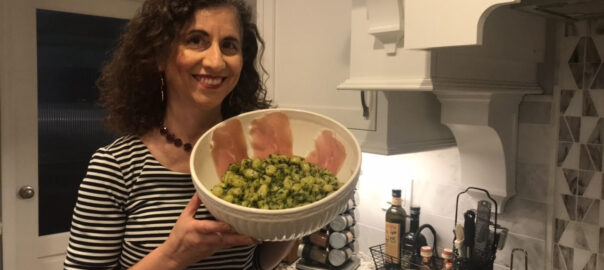Pesto alla Genovese with Gnocchi: Everything You Always Wanted to Know About Making Pesto!
Pesto alla Genovese is a method that has withstood the test of time!
Pesto alla Genovese with Gnocchi: Everything You Always Wanted to Know!
Pesto alla Genovese with Gnocchi: Everything You Always Wanted to Know about Making Pesto! is a partial reprint from a blog originally posted on October 11, 2017, titled: “Pesto alla Genovese Meets American Aquaponic Farming in Chicago.”
This summer I have had the usual bumper crop of fresh basil leaves from the basil plants in large pots that I keep in a sunny position in my garden and provide with an abundance of water. The plants started to go to seed — make the green and white column of flowers at the end of each stalk — by mid June. So, I dutifully cut back my basil: at first just the flowers, then the stalks with the flowers, and then in mid July did a hard ct-back, taking both stalks and leaves, leaving about 50% of each plant. This will enable the basil plants in the pots to keep growing new stalks with new basil leaves, hopefully into August. (For more information about how to grow basil, visit my Instagram, Conversationalitalian.french.)
This procedure left me with an abundance of basil stalks and leaves, which luckily love to create new roots in a vase of water and will last a few weeks or even a month. I also love to make pesto at least 2-3 times a summer when I have an abundance of fresh basil leaves.
There is truly nothing like the fresh aroma of newly crushed basil over a warm bowl of pasta. And best of all, my children love it!
Read the reprinted blog below to learn “everything you always wanted to know” about making pesto. I give a short history about my experiences trying to make basil, the best (Genovese) basil plant to use and the theory behind the method. I have included a video in the original blog about how to use a marble mortar and wooden pestle — essential equipment — no food processors, please!
Finally, at the end of this blog I have reprinted the recipe with the proportion of basil, garlic and cheeses that I like. Try my method and modify the ratio of ingredients for your family!
Also…
I’ve since added Instagram to my social media, and have added a video from Instagram to this post so you can see me creating pesto in real-time! I hope you like it!
For more recipes like these, as well as French recipes, follow me on my Instagram posts at Conversationalitalian.french.
View this post on Instagram
And now… the original story!
Pesto alla Genovese is the famous bright green “pasta sauce” from the northern Italian region of Liguria, whose capital is the city of Genoa. My introduction to pesto, which was not a part of my southern Italian upbringing, was from one of those little glass jars I found in a grocery store in Peoria, Illinois. The jar had been labeled “pesto” by an Italian company. Back then, I was trying to learn to cook true Italian “regional” cooking and specifically to expand my sauce-making techniques beyond the ubiquitous and well-loved southern Italian red tomato sauce. Read the full post here: Pasta alla Genovese.
—Kathryn Occhipinti

Ingredients for Italian Recipe
Kathryn’s Pesto alla Genovese
(Serves 4)
Small leaves from 1 small sweet basil plant (Genovese basil is best!)
(about 3 cups of lightly packed leaves, rinsed, patted dry, stems removed)
1 to 2 small garlic cloves, peeled, halved lengthwise
(and bitter green center removed if present)
2 tablespoons Italian pine nuts
2/3 cup freshly grated Parmesan cheese
1/3 cup freshly grated Romano cheese
1/4 tsp salt
3/4 cups of extra virgin olive oil, from Liguria, if possible
If desired: Prosciutto to line the bowl of gnocchi and pesto dressing for serving.
Method for the Pesto
Note: Before starting, set a large pot of well-salted water on the stove to boil, and cook your pasta or gnocchi to “al dente” tenderness (“to the tooth). Time the pasta so it finishes cooking just before the pesto is complete. Keep in mind that fresh pasta and gnocchi will take far less time to cook than dried pasta.
- Put the garlic cloves into the mortar with a few grains of salt and begin to crush. Add the pine nuts and continue to crush into a smooth paste.
- Remove the garlic/pine nut mixture from the mortar to a small bowl.
- Put a few of the basil leaves and a few grains of salt into the mortar and begin to crush, using the method shown in the link to the video in this blog post.
- As the basil leaves become crushed and release their essential oils, add a few more. Continue to crush the leaves, adding a few at a time, until all are crushed fairly uniformly.
- Add whatever salt is left to the crushed basil leaves, the garlic/pine nut mixture, and then drizzle in a bit of olive oil. Combine.
- Add the cheeses and a bit more olive oil. Combine.
- Drizzle in the rest of the olive oil while continuously stirring the garlic/pine nut/ crushed basil/cheese mixture until a creamy dressing has formed.
- Reserve 1 to 2 tablespoons of pasta water and mix into the pesto to warm.
- Quickly drain the pasta and put the warm pasta into a large serving bowl.
- Dress with your pesto, mix to coat, and serve immediately!
- If desired, as in the Instagram video above, line a large bowl with prosciutto and carefully added your pesto dressed gnocchi. Allow gnocchi to warm the prosciutto a bit, and then serve. This idea from John Coletta’, chef of Quartino Restaurant in Chicago, in his cook book titled: “250 True Italian Pasta Dishes.”

- If you would like to preserve your pesto rather than use it right away, it can be frozen in small plastic containers. Top off with a small amount of olive oil. Leave a small amount of room in the container for the liquid to expand and then cover.
Kathryn Occhipinti, MD, is the author of the
Conversational Italian for Travelers series of books and a teacher of Italian for travelers to Italy in the Peoria and Chicago area.
“Everything you need to know to enjoy your visit to Italy!”
Join my Conversational Italian! Facebook group and follow me on Twitter at StellaLucente@travelitalian1 and start to learn Italian today for FREE!
Conversational Italian! Facebook Group
Tweet @travelitalian1 for Stella Lucente Italian
YouTube videos to learn Italian are available from © Stella Lucente, LLC.
Learn Conversational Italian.
More information on and photographs of Italy can be found on Facebook Stella Lucente Italian and Pinterest Stella Lucente Italian.
Facebook Stella Lucente Italian
Pinterest Stella Lucente Italian
Visit learntravelitalian.com/download.html to purchase/download Conversational Italian for Travelers and find more interesting facts and helpful hints about getting around Italy! Learn how to buy train tickets online, how to make international and local telephone calls, and how to decipher Italian coffee names and restaurant menus, all while gaining the basic understanding of Italian that you will need to know to communicate easily and effectively while in Italy. —From the staff at Stella Lucente, LLC
Pesto alla Genovese with Gnocchi: Everything You’ve Always Wanted to Know about Making Pesto!
